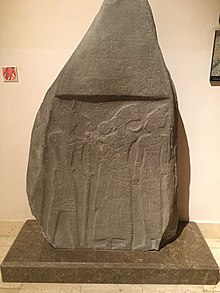The Balu'a Stele is a basalt stele (inscribed stone) with a near completely unreadable Egyptian hieroglyphic inscription and relief panel. It was discovered in 1930 at the Khirbet al-Balu'a site north of the city of Karak and is thought to date to 1309–1151 BCE.[1] The finding site is on the territory of the land of Moab, but the ethnical identity of the person who has carved it cannot be asserted.[2] The iconography contains Canaanite elements, while the overall composition strictly conforms to Egyptian canons.[2] It has been interpreted as representing two deities investing a Canaanite king, whom Egyptians would have seen as "Asiatic" and probably Shasu.[2]
| Al-Balu' Stele | |
|---|---|
 Al-Balu' Stele on display at the Jordan Museum | |
| Material | Basalt |
| Writing | Egyptian language[1] |
| Created | 1309–1151 BCE[1] |
| Discovered | 1930 |
| Present location | Jordan Museum |
References
edit- ^ a b c Department of Antiquities of Jordan The Balu'a Stele: A New Transcription With Palaeographical And Historical Notes Annual of the Department of Antiquities of Jordan 08/9 http://publication.doa.gov.jo/Publications/ViewChapterPublic/635
- ^ a b c Routledge, Bruce; Routledge, Carolyn (1 January 2009). "The Balu'a Stele Revisited". Studies on Iron Age Moab and Neighbouring Areas in Honour of Michele Daviau. Retrieved 28 January 2020.
Further reading
edit- Schroer, Silvia (2011). Die Ikonographie Palastinas/Israels und der Alte Orient: eine Religionsgeschichte in Bildern, Band 3: Die Spätbronzezeit (in German). Academic Press Fribourg. p. 324. ISBN 978-3-7278-1671-0.